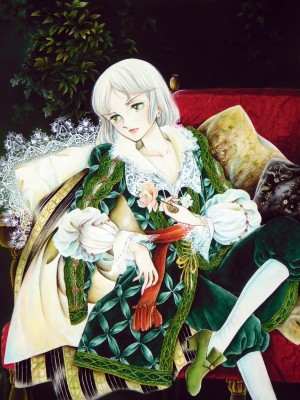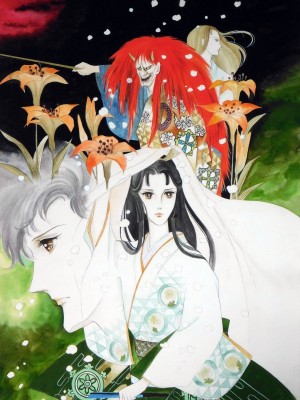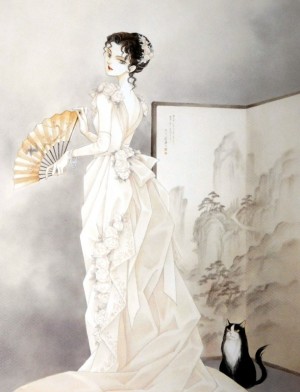The World of Japanese Girls’ Comics
April 7, 2016 · 0 comments
Lee Brimmicombe-Wood looks for the mojo in shojo.
 The touring exhibition of shojo manga, which finishes its run at London’s House of Illustration in June, is not so much about comics as about the shojo aesthetic. The exhibition presents a world of slender, beautiful men, of flowers, of soft-edged pastels. If you knew nothing of the shojo genre, you will find this a gentle introduction to some of its archetypes.
The touring exhibition of shojo manga, which finishes its run at London’s House of Illustration in June, is not so much about comics as about the shojo aesthetic. The exhibition presents a world of slender, beautiful men, of flowers, of soft-edged pastels. If you knew nothing of the shojo genre, you will find this a gentle introduction to some of its archetypes.
However, it’s viewed through a very narrow lens. The tiny gallery space is dominated not by comics pages but by prints of posters, cover art and splash pages.
The prints have been reproduced at Kyoto Seika University by an elaborate process known as Genga’(Dash), in which scans of the original art have been processed not to eliminate flaws but to preserve them. Colour-matched by eye and then printed onto cold-pressed watercolour paper, this is an archival effort that allows international exhibition of otherwise delicate works.
The leader of this project is the great Keiko Takemiya, one of the artists featured in the exhibition. Takemiya made her name as part of a wave of women artists known as the Year 24 Group because they were all born around year Showa 24 (1949) and who came into the industry in the late 1960s. Along with Year 24 alumnus Moto Hagio, Takemiya was a pioneer of Bildungsroman comics about homosexual boys. Her 1976 series The Poem of the Wind and the Trees is one of the founding classics of the Boy’s Love genre, in which a troubled young aristocrat and a tortured dissolute boy are drawn into a relationship with each other at a 19th Century school.
A couple of prints from The Poem of the Wind and the Trees appear in the exhibition, showing languid men kissing in a pastel garden. Takemiya has a distinctive, bold line that is somehow simpler and more direct than the polished technicians that followed.
The other two artists featured here. Yukiko Kai and Akiko Hatsu are just such technicians, both from the Post-Year 24 wave. They are such curious choices for an exhibit that one wonders whether they were friends of Takemiya. Certainly both had served apprenticeships as assistants to Year 24 artists.
 Yukiko Kai’s story is the most compelling, having flourished in a very brief career for various Princess magazine imprints in the late 1970s before dying at the age of 26 from stomach cancer. Amongst her works here are images from Anastasia’s Wonderful Neighbour, a playful fantasy involving a five year-old and the benign witch that lives next door.
Yukiko Kai’s story is the most compelling, having flourished in a very brief career for various Princess magazine imprints in the late 1970s before dying at the age of 26 from stomach cancer. Amongst her works here are images from Anastasia’s Wonderful Neighbour, a playful fantasy involving a five year-old and the benign witch that lives next door.
The other artist is Kai’s sister, Akiko Hatsu, who started her own career assisting both her older sister and the great Moto Hagio. After Kai died in 1980, Hatsu turned professional and amongst her earliest work is the Boy’s Love story Perfect Gentleman, represented in the exhibition as a sepia-toned print of the protagonists. She also does a line in ghost stories, such as Uryudo Dream Tales, about an antiques shop in the Meiji period and the spirits that haunt its artefacts.
As with Takemiya, the focus is on covers and splashes, mostly in watercolour. Yukiko Kai’s work tends to the kind of strong lines and simple, lush figures more typical of 1970s boys’ and girls’ comics. In her colour work she tends towards fruity reds and pinks. Akiko Hatsu’s line is more severe, her figures—male and female—sharp and angular. Hatsu’s colours tends towards secondary, almost desaturated, hues that complement her delicate line work.
Here, then, is an encapsulation of a particular girl’s comics aesthetic that runs from the 1970s to the 1980s. It ranges from simple and bold to florid and delicate. It is flowery and soft-edged, romantic and even spooky, and aimed at an audience capable of accepting stories of homosexual love and sexual abuse.
 For an English viewer, it makes for a fascinating contrast with the British girls’ comics of the same era whose style, forged predominantly by male British and Spanish artists, was far more prosaic than lyrical. And though titles, such as the horror anthology Misty, could be quite sophisticated in their storytelling, sex was completely off the agenda. Another point of reference is American romance comics, which again were male created and focussed on a firmly hetero path from date night to the altar.
For an English viewer, it makes for a fascinating contrast with the British girls’ comics of the same era whose style, forged predominantly by male British and Spanish artists, was far more prosaic than lyrical. And though titles, such as the horror anthology Misty, could be quite sophisticated in their storytelling, sex was completely off the agenda. Another point of reference is American romance comics, which again were male created and focussed on a firmly hetero path from date night to the altar.
What the exhibition doesn’t do is give an overview of the full richness, style and context of shojo manga. There are no other pioneering artists, the work is limited to the 1970s and 1980s, and there’s precious little variety of content. Here is Takemiya exhibiting some of her colour prints and those of a couple of well-regarded protégés. Comics are almost absent and the visitor may well fall thirstily upon the handful of pages on display. One such is a set of from Akiko Hatsu’s adaptation of Kyoka Izumi’s novel Yashagaike Pond, which is worth admiring for the inking and finishing work—the scratchy, energetic keylines around her figures and the way in which panel transitions have been softened by smoke and shadow.
As it stands, the shojo manga exhibit stands as a flowery appendage to the far more robust Comix Creatrix: 100 Women Making Comics. This is in the same venue and a ticket to the shojo exhibition will get you into both. Comix Creatrix displays work from women across the world and a wide variety of subject matter, arranged thematically. Creators include the usual suspects such as Claire Bretecher, Lynda Barry, Alison Bechdel and Tove Jansson, but you’ll also find contributors to 2000 AD, Judge Dredd, Viz and the Anglo-American underground scene. Thoughtfully curated, it’s everything the shojo exhibit is not—which is to say an eye-opener on a wide world of women’s comics, rather than a precious display of a single aspect.
Shojo Manga: World of Japanese Girls’ Comics exhibits until 12th June and Comix Creatrix: 100 Women Making Comics until 12th May, both at the House of Illustration, London.
Akiko Hatsu, comics, House of Illustration, Japan, Keiko Takemiya, manga, museums, Yukiko Kai
Leave a Reply